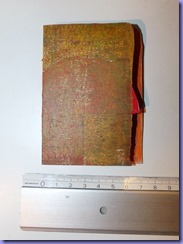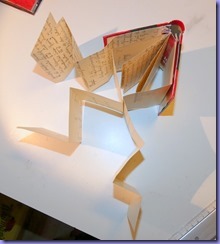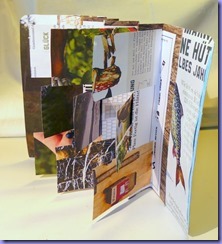Activity 6.2.1 Searching for freestanding book designs
Loads of fascinating artists’ books! Here are only a few ...
I was also fascinated by the work of Dresden-based artist Marí Emily Bohley (http://www.mari-emily-bohley.de/index.php)
The immense variety of artists’ books I found on the web is amazing, but the more I saw the more I felt stunned and even a bit discouraged. To overcome this feeling of inadequacy I tried to isolate the features I find attractive.
1. I was mostly drawn to books in black and white or in a limited range of colours (which goes well with my chosen theme).
2. I like zigzags and signatures.
3. I like the form of a traditional book.
4. I feel I would like to use a simple basic construction, with the option of putting in interesting details as they come up.
These thoughts were in my mind when I made the samples.
6.2.2 Sample Display Books
I used decorated papers, mostly taken from magazines and copies from children’s books.
| 1. Simple concertina book | 14x11 cm |
 |  |
| A simple zig zag book to get started. The cover folds around the book. | I cut the top edges in waves and other shapes. |
| | |
| 2. Simple zig zag with signatures | 7x10 cm |
 |  |
| A small notebook-like zig zag, very compact. The book cover which is also the spine is a magazine cover printed with acrylics and a gelli plate. The small red edge on the right is left from the original design on the cover. | The signatures with their book-like appearance suggest text to me. What words would I like in my book? I should continue the collection I began when thinking about my theme.
|
| | |
| 3. Concertina with more signatures | 10,5x10,5 cm |
 | For this sample I folded the concertina first and added the covers separately.
 |
 |
Some of the signature pages are also folded like a small concertina. |
| | |
| 4. Book cover with several concertinas | 8,5x11 cm |
 |  |
| I gutted an old notebook and glued in a folded piece of card as a spine. | I glued three concertinas in the folds and also sewed in a signature. |
 |  |
| The concertinas folded out. (It looks like a mutated frog.) The folds of the first concertina I made were too deep and I had to fold them again. | The folded spine would allow for a few more signatures and / or concertinas. |
| | |
| 5. A flag book | 9,5 x 18 cm |
 |  |
 | I made the flag book just to learn the principle. Although I had read the instructions I did not understand how it would work. Fortunately the instructions are so clear that I could follow them without understanding what I did. It turned out to be quite simple.
I like how the book spreads out to become an image – but one can also turn the pages like in a traditional book. |
| | |
| 6. A zig zag with signatures on both sides | 10,5 x 12,5 cm |
 | The book cover is made from a thick piece of card, this gives a lot of stability, even when the zig zag is folded out.
I think my finished book will be constructed more or less like this sample. I feel that even with this simple form there are a lot of possibilities for variation and decoration. |
 |  |
 | Considering that the zig zag will be seen from both sides there is a lot of space to be filled. Quite intimidating! |
| | |
 | All my samples |
| | |
| Preparation for the finished book: | 17x24 cm |
 | This was a bound magazine from a library, made from very thick and tough bookbinders’ carton. For a start I cut out the pages.
 |
| Could I put in one element on each side? Could I incorporate a flag book element? | I am sure planning has just begun … |
